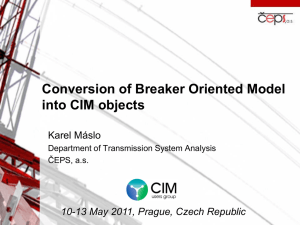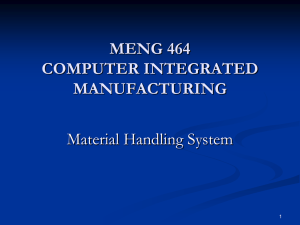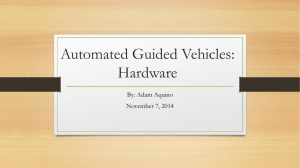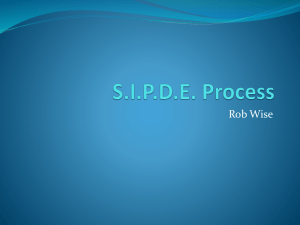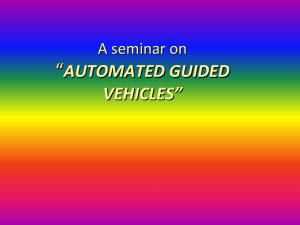file5
advertisement
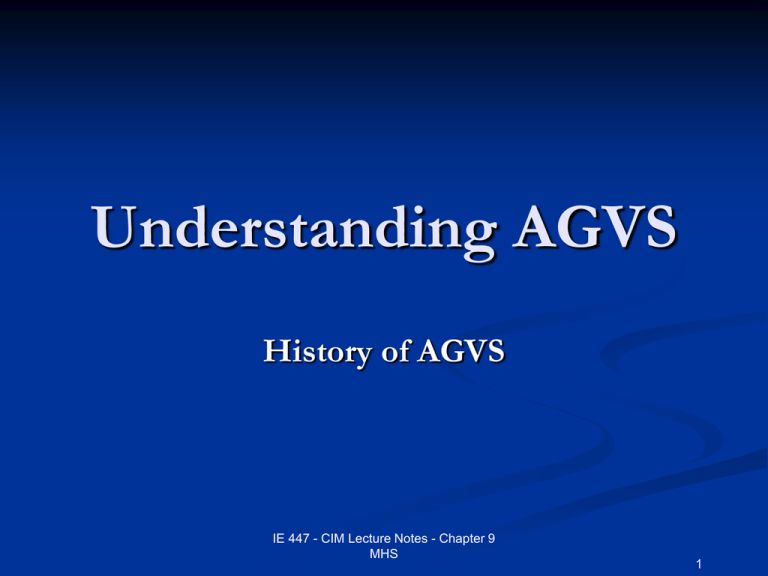
Understanding AGVS History of AGVS IE 447 - CIM Lecture Notes - Chapter 9 MHS 1 History of AGVS 1953 First AGV The first AGV system was built and introduced in 1953( A modified towing tractor that was used to pull a trailer and follow an overhead wire in a grocery warehouse) IE 447 - CIM Lecture Notes - Chapter 9 MHS 2 History of AGVS 1973 Volvo Assembly Plant In 1973, Volvo in Kalmar, Sweden set out to develop non-synchronous assembly equipment as an alternative to the conventional conveyor assembly line. The result was 280 computercontrolled assembly AGVs. IE 447 - CIM Lecture Notes - Chapter 9 MHS 3 History of AGVS 1970s First Unit Load Introduction of a unit load vehicle They have the ability to serve several functions; a work platform, a transportation device, and a link in the control and information system They transport material in warehouses, factories, mills, hospitals, and other industrial and commercial settings. IE 447 - CIM Lecture Notes - Chapter 9 MHS 4 History of AGVS Smart Floors and Dumb Vehicles In the 1970’s the principal guidance technology was to induce an electronic frequency through a wire that was buried in the floor. ‘floor controller’ •These first generation navigation schemes were expensive to install. •All floor cuts needed to follow the exact path of the AGV. IE 447 - CIM Lecture Notes - Chapter 9 MHS 5 History of AGVS Dead Reckoning Capability As the vehicles became more intelligent, the path became less sophisticated Dead reckoning is a term that describes the ability of a vehicle to traverse steel expansion joints on the factory floor or to cross a steel grate The biggest advantage was that dead reckoning eliminated the need to make the cut radius turns at intersections. (Installation was greatly simplified). IE 447 - CIM Lecture Notes - Chapter 9 MHS 6 History of AGVS 1980s Non-Wire Guidance The introduction of laser and inertia guidance. Allow for increased system flexibility and accuracy No need for floor alterations or production interruption IE 447 - CIM Lecture Notes - Chapter 9 MHS 7 AGV NAVIGATION The principles which make it possible for an AGV to navigate its way between any two locations are really quite simple. All navigation methods use a path. The vehicle is instructed to Follow a Fixed Path or Take an Open Path. IE 447 - CIM Lecture Notes - Chapter 9 MHS 8 Fixed Path Navigation Following a Path The paths are well marked on the floor The paths are continuous The paths are fixed, but can be changed IE 447 - CIM Lecture Notes - Chapter 9 MHS 9 Fixed Path Navigation: Creating a Path The principle techniques for creating paths are to: Apply a narrow magnetic tape on the surface of the floor Apply a narrow photo sensitive chemical strip on the surface of the floor Apply a narrow photo reflective tape on the surface of the floor Bury a wire just below the surface of the floor IE 447 - CIM Lecture Notes - Chapter 9 MHS 10 Fixed Path Navigation: Buried Wire Path Bury a current-carrying wire just below the surface of the floor IE 447 - CIM Lecture Notes - Chapter 9 MHS 11 Fixed Path Navigation: Steering Correction Coils The vehicle steers itself to FOLLOW the magnetic field surrounding the buried wire. IE 447 - CIM Lecture Notes - Chapter 9 MHS 12 Fixed Path Navigation: Path Selection In this illustration, a vehicle at “A” has two choices on how to get to “B”. A computer either on board the vehicle or at some central location selects a path based on established criteria. Criteria: The shortest distance The path with the least traffic at the present time All of the “PATH FOLLOWING” methods permit routing options that include guide path switching and merging. IE 447 - CIM Lecture Notes - Chapter 9 MHS 13 Open Path Navigation: Taking a Path Unlike “path following navigation,” where the guide paths are fixed, and more or less permanent, vehicles operating in the “Take a Path” category are actually offered more variation if not an infinite number of ways to navigate the open space between two points. IE 447 - CIM Lecture Notes - Chapter 9 MHS 14 Open Path Navigation: Navigation Methods The three most common open space navigation methods are: Laser Guidance Inertial Guidance Cartesian Guidance The choice of navigation method for a particular application is often a simple matter of preference. IE 447 - CIM Lecture Notes - Chapter 9 MHS 15 Navigation Methods - Laser Guidance Reference points are strategically located targets A beacon on top of the vehicle emits a rotating laser beam which is reflected back to the vehicle when it strikes (sees) a target. IE 447 - CIM Lecture Notes - Chapter 9 MHS 16 Navigation Methods - Inertial Guidance An on board gyroscope establishes and maintains a vehicle’s heading. Distance traveled is calculated by an on board encoder which counts wheel rotations. IE 447 - CIM Lecture Notes - Chapter 9 MHS 17 Navigation Methods – Cartesian Guidance Location precision is accomplished by way of a fixed grid pattern that covers the entire floor area. The possible travel paths in a given, unrestricted operating area for a grid based system are infinite and most like that provided by laser guidance IE 447 - CIM Lecture Notes - Chapter 9 MHS 18 AGVS Dispatching Dispatching AGVS is much the same as dispatching taxi cabs. The dispatch function makes sure that all customers get timely services from the vehicle best able to service a request. Remote and local dispatch are most commonly described as offboard and onboard dispatchers respectively. IE 447 - CIM Lecture Notes - Chapter 9 MHS 19 AGVS Communications Communications include message commands such as: where to go, when to start, when to slow down, when to stop. Four types of basic communication media: Radio Communication Infrared Communication Guide Wire Data Communication Inductive Loops Communication IE 447 - CIM Lecture Notes - Chapter 9 MHS 20 AGVS Communications Radio Communication Maximum flexibility in system control Vehicles can be programmed “on the fly” system speed of response to changing load movement demands is improved IE 447 - CIM Lecture Notes - Chapter 9 MHS 21 AGVS Communications Infrared Communication Optical infrared communication is highly reliable but has the disadvantage of not being continuous; it is point to point. Vehicles may be stopped during this data exchange which usually occurs at load stations where the fixed and mobile units are aligned and in close proximity. Or, the vehicle communicates at fixed points along its guide path as the vehicle travels through a given zone. Infrared communication is best suited for small systems with few vehicles and load stations. IE 447 - CIM Lecture Notes - Chapter 9 MHS 22 Remote Dispatching The Dispatcher The remote dispatch function generally resides in a computer (PC), Programmable Controller (PLC), or other microprocessor, known as the Dispatcher. The Dispatcher accepts input from the various system Components (generally transport requests) and directs the AGVS to fulfill the command in the most efficient manner. Remote dispatch can occur with vehicles at single or various dispatch points. IE 447 - CIM Lecture Notes - Chapter 9 MHS 23 AGVS Monitoring Types of monitoring : System monitoring Vehicle monitoring The functions and reporting capabilities of each are important to the safe operation of the AGVs. IE 447 - CIM Lecture Notes - Chapter 9 MHS 24 Material Handling Systems Automatic Storage Retrieve Systems AS/RS IE 447 - CIM Lecture Notes - Chapter 9 MHS 25 IE 447 - CIM Lecture Notes - Chapter 9 MHS 26 IE 447 - CIM Lecture Notes - Chapter 9 MHS 27 IE 447 - CIM Lecture Notes - Chapter 9 MHS 28 IE 447 - CIM Lecture Notes - Chapter 9 MHS 29 IE 447 - CIM Lecture Notes - Chapter 9 MHS 30


